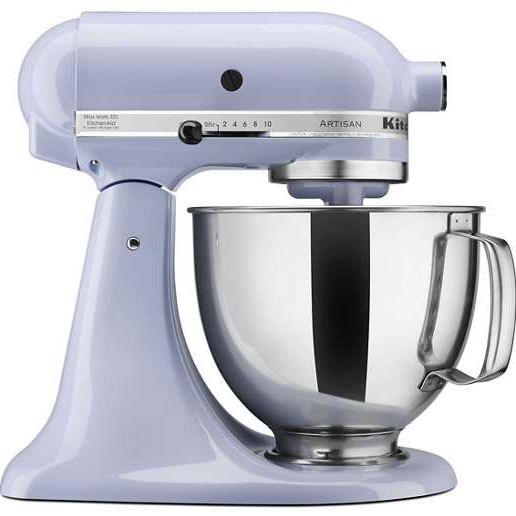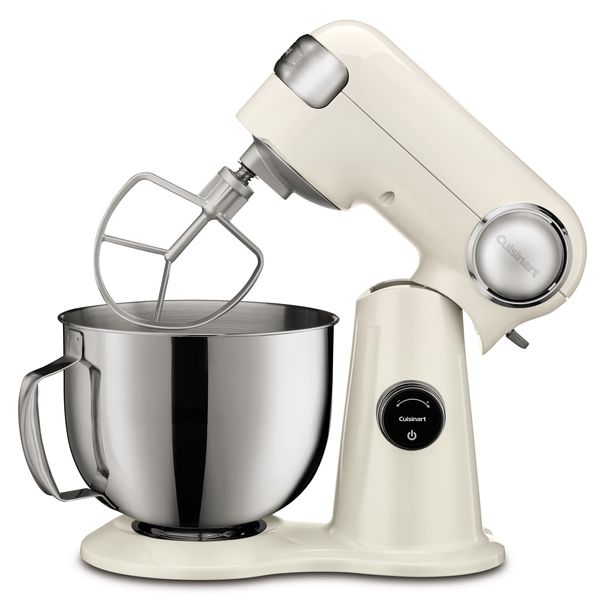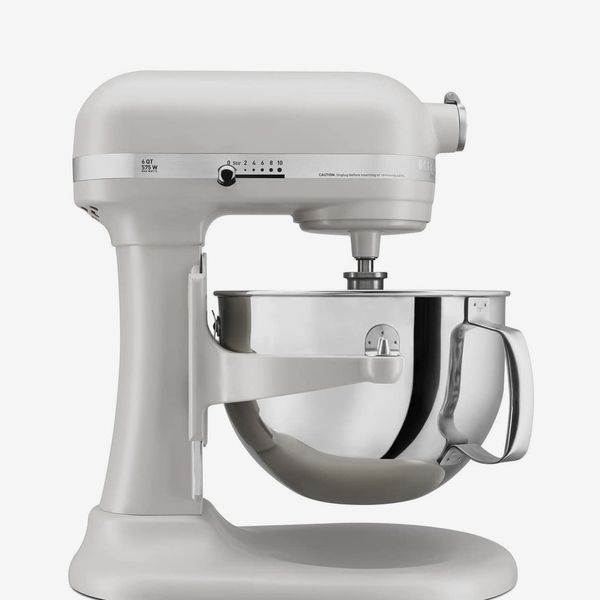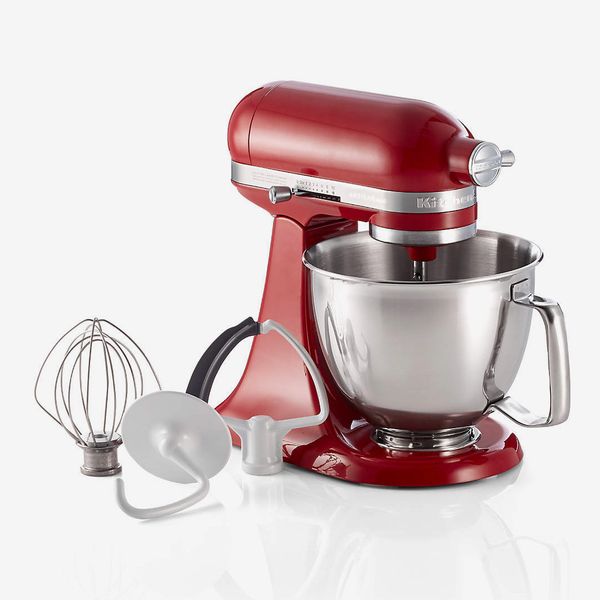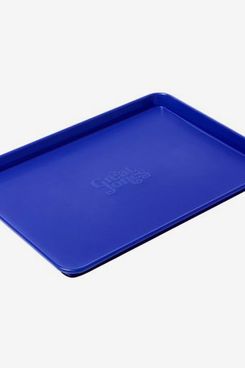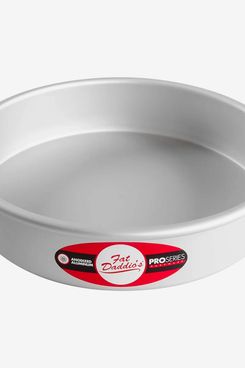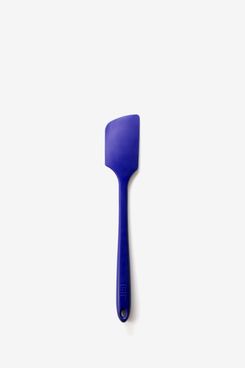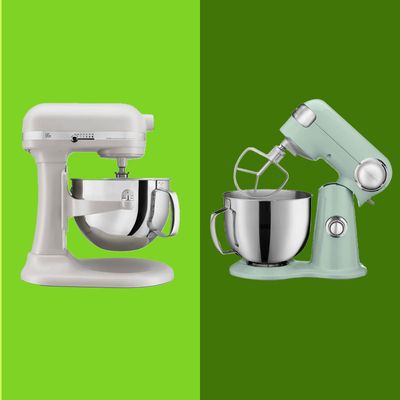
In this article
The first real grown-up piece of kitchen equipment I got my hands on was a KitchenAid Tilt-Head stand mixer (it was a gift from my parents when I moved to New York nearly a decade ago). I’ve lugged it from apartment to apartment, always finding a place for it on my counter, in a cabinet, or, currently, on the top of the fridge. The machine still works as well as it did when it was brand new, and I imagine I’ll own it for another decade to come.
When it comes to stand mixers, choosing a KitchenAid was kind of a no brainer. I didn’t think twice about requesting one at the time because it was the brand I grew up using when baking with my mom. It also turns out that KitchenAid rules — like really rules — this particular corner of the appliance market. Nearly every professional baker and cook I talked to for this piece named the company as their favorite, hence why the brand’s various models make up the vast majority of picks on this tight list. At around $400 a pop no matter which one you go with, they’re a real investment. But I’ll say this: If you bake a lot, the price tag is worth it. If you just can’t swing it, or you only bake on occasion, we’ve got a more affordable enthusiastically-endorsed option (and I’m on the hunt for even more great budget picks as we continue to update this post). And if you’re in the market for the best bakeware — once you’ve thoroughly beaten your doughs and batters — I’ve got you covered there, too.
What we’re looking for
Capacity
Capacity refers to the amount the bowl of a stand mixer can hold and is measured in quarts. About five quarts is standard (technically, this has enough room for dough for about 100 cookies according to the pros, but more meaningfully, it will comfortably fit a double or even triple batch of cookies, the batter for a layer cake, and a whole lot of whipped cream). If you’re pressed for space, there’s a mini option that will still accommodate pretty much any recipe you can think of, too.
Speeds
The wattage of the motor will determine how powerfully a stand mixer stirs, and anything above 300 is considered strong. Every model here delivers on this front (with one exception — the mini KitchenAid — which boasts 250 watts, which is proportionate to its smaller size). What’s more important is the number of speeds, various levels you can control and cycle through. These refer to how fast the attachments spin. Beating eggs and whipping cream, for example, will require a higher speed than kneading dough. The more speed settings you have, the more control you have over consistency.
Optional attachments
Every machine on this list comes with three standard attachments: a dough hook, a whisk, and a flat beater. These are everything you need to complete most baking and cooking tasks. But each also offers additional attachments for purchase that can completely transform your machine into something else, from a meat grinder, to a pasta-maker, to a vegetable spiralizer. Here, I’ve noted how many attachments are available for each and gone into further detail within each caption.
Best stand mixer overall
Capacity: 5 quarts | Speeds: 10 | Optional attachments: Over 20
This is the stand mixer I own — and I love it. Like I said, it’s lasted me nearly a decade, and I use it a couple of times a month, give or take. That scores big points for durability, as it should be when you’re investing in such a pricey appliance. (And if that’s not enough to convince you, Matt Holloway and Michelle Davis, the duo behind the Bad Manners podcast and cookbooks, have been using theirs for twice as long, and it’s still going strong. “This is a product you buy for life,” they told me.)
The motor is powerful: Whether I’m kneading dough on a lower setting for a longer amount of time, or whipping cream on high for just a few minutes, the consistency of my mixtures turns out even and well-combined. I also like the tilt head. It unlocks and moves up — making it easy to add ingredients — then relocks firmly and securely into a downward position when it’s time to mix. The whole contraption is heavy, but in my mind that’s a good thing: It stays firmly planted to the counter when in use. It’s a plus for recipe developer and pro baker Samantha Seneviratne, too, who notes that her mixer kneads through batches of yeasted dough without shaking.
On to the settings. The range between the speeds is wide, which allows it to accommodate many different types of doughs and batters — but the difference between the settings is also subtle-enough to allow for maximum control. When I add flour, for example, I start low so it doesn’t puff up everywhere, and then gradually increase seamlessly until it’s all incorporated. If I find I’m not going quite fast enough to get my eggs and sugar pale and airy, a small tick upwards gets me there without overdoing it. John Kanell, cookbook author and founder of Preppy Kitchen, is yet another fan, and also points out that control: “It can really mix anything from light fluffy meringues to super dense batters and candies,” he says.
Finally, if you’re interested in purchasing attachments, KitchenAid makes an incredibly thorough guide to the more than 20 options that work with this mixer.
Best less expensive stand mixer
Capacity: 5.5 quarts | Speeds: 12 | Optional attachments: 5
While this Cuisinart stand mixer still costs a couple hundred dollars, it’s significantly less than the other models on this list — and if you can’t splurge, it’s a great bet. In fact, recipe developer Lili Dagan says she reaches for it more than her KitchenAid Professional mixer (the exact version of which is currently off the market anyway). “I find that the cheaper and aesthetically similar Cuisinart gets the job done,” she says, adding that it’s just as powerful as the KitchenAid. (Indeed, the wattage is even higher, so this makes sense.) The Cuisinart has a slightly bigger capacity, and a couple more speeds, too. And Dagan also prefers the actual mechanism for hiring and lowering speeds, which you control via a knob instead of pull-tab. “There’s less clonk,” she says. The final plus: It’s available in 17 shades (sounds silly, but I do believe finding your color match for an appliance like this is part of the fun, so it’s nice that a brand besides the reigning one offers such options). As for attachments, the brand offers a frozen dessert maker, a meat grinder, a pasta extruder, a pasta roller and cutter, and a spiralizer.
Best bowl-lift stand mixer
Capacity: 7 quarts | Speeds: 11 | Optional attachments: Over 20
This KitchenAid model is built to be even heavier-duty than the best overall pick. It weighs more, has a larger bowl capacity, a broader base for even more stability, and a bit more power to the motor (so it can easily handle thicker mixtures). As such, it’s built a bit differently, too: Instead of a tilt head, the top stays firmly in place, but the bowl, attached securely by arms that wrap around it, moves up (to mix thoroughly) and down (to create an opening to add ingredients) via a lever. KitchenAid has a handy guide to compare the two, as well, if you want to read even more in-depth specifications about the differences.
Recipe developer and cookbook author Jessie Sheehan has owned this model for about seven years and attests to how strong and sturdy it is. She also appreciates how smoothly the speed change mechanism and lever work. “It’s still a well-oiled machine after all this time,” she says. The bowl is big, no doubt: Sheehan says that size came in handy back when she was doing more “mom things” like baking big birthday cakes or class treats for her kids. And there’s one additional plus: since the bowl drops down, you get a better view of what’s going on inside. “That’s the quality I’m most struck by,” she says. “With baking, you’re going by sight signifiers more than time.”
I’ve used this one a handful of times over the years in other peoples’ kitchens, too, and while I personally prefer the tilt-head (simply because that’s all I need, and all I have room for anyway), I do think this one would be the smarter buy if you’re turning out baked goods on a regular basis and in a larger capacity. Holloway and Davis say the same: “If you spend a lot of time in the kitchen or know you cook for a crowd, the bowl-lift models are the way to go.”
Again, if you’re interested in purchasing attachments, read KitchenAid’s incredibly thorough guide to the more than 20 options that work with this mixer.
Best small stand mixer
Capacity: 3.5 quarts | Speeds: 10 | Optional attachments: Over 20
On the opposite end of the spectrum, KitchenAid makes a mini stand mixer that’s 25 percent lighter and 20 percent smaller than the tilt-head version. As I mentioned earlier, the lower wattage means it isn’t quite as powerful as its full-sized counterparts — but it doesn’t need to be because it’s not meant to accommodate particularly large batches where you’re mixing heaploads of ingredients. Don’t worry though: It’s still plenty big, enough to accommodate any standard-size recipe. Otherwise, it behaves exactly the same and still features ten speeds for maximum control.
Erica Murphy, senior commerce director at Hearst and an avid home baker, originally recommended the model back in 2016, shortly after it came out. It was a perfect fit for her “cardboard box–size apartment,” she says, where a heavier, bulkier machine simply wasn’t going to fit. She was skeptical, at first, that the contents of her bowl (especially liquidy ones) would splatter, but was pleased to find that wasn’t an issue. Since the rest of the appliance is proportional to the bowl, everything stays put.
Here, the mixer can accommodate all the same attachments as the previous two models, except for the ice-cream maker.
Some more baking essentials we’ve written about
Our experts
• Lili Dagan, recipe developer
• Michelle Davis, co-host and co-author of the Bad Manners podcast and cookbooks
• Matt Holloway, co-host and co-author of the Bad Manners podcast and cookbooks
• John Kanell, cookbook author and founder of Preppy Kitchen
• Erica Murphy, senior commerce director at Hearst
• Samantha Seneviratne, recipe developer and cookbook author
• Jessie Sheehan, recipe developer and cookbook author
Additional reporting by Rachael Griffiths.
The Strategist is designed to surface the most useful, expert recommendations for things to buy across the vast e-commerce landscape. Some of our latest conquests include the best acne treatments, rolling luggage, pillows for side sleepers, natural anxiety remedies, and bath towels. We update links when possible, but note that deals can expire and all prices are subject to change.
Every editorial product is independently selected. If you buy something through our links, New York may earn an affiliate commission.

